change wheel PONTIAC BONNEVILLE 1994 Owners Manual
[x] Cancel search | Manufacturer: PONTIAC, Model Year: 1994, Model line: BONNEVILLE, Model: PONTIAC BONNEVILLE 1994Pages: 290, PDF Size: 14.75 MB
Page 133 of 290
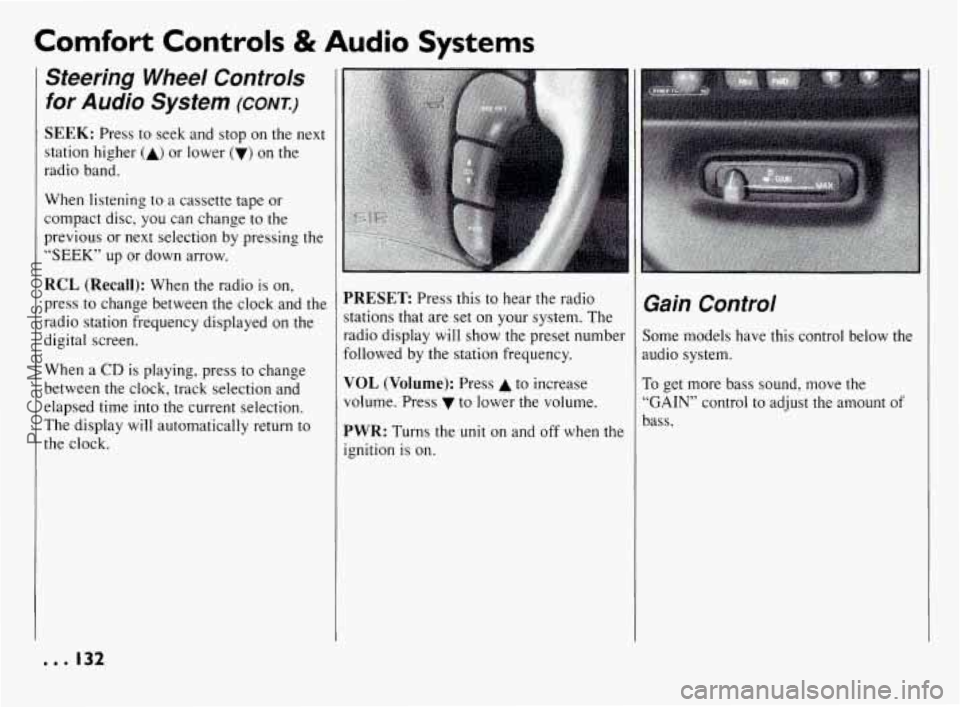
Comfort Controls & Audio Systems
Steering Wheel Controls
for Audio System (CONK)
SEEK: Press to seek and stop on the next
station higher
(A) or lower (V) on the
radio band.
When listening to a cassette tape or
compact disc, you can change
to the
previous or next selection by pressing the
“SEEK” up or down arrow.
RCL (Recall): When the radio is on,
press
to change between the clock and the
radio station frequency displayed on the
digital screen.
When a
CD is playing, press to change
between the clock, track selection and
elapsed time into the current selection.
The display will automatically return to
the clock.
PRESET Press this to hear the radio
stations that are set on your system. The
radio display will show the preset number
followed by the station frequency.
VOL (Volume): Press A to increase
volume. Press to lower the volume.
PWR: Turns the unit on and off when the
ignition is on.
Gain Control
;ome models have this control below the
mdio system.
To get more bass sound, move the
.GAIN” control to adjust the amount of
)ass.
--. I32
ProCarManuals.com
Page 143 of 290
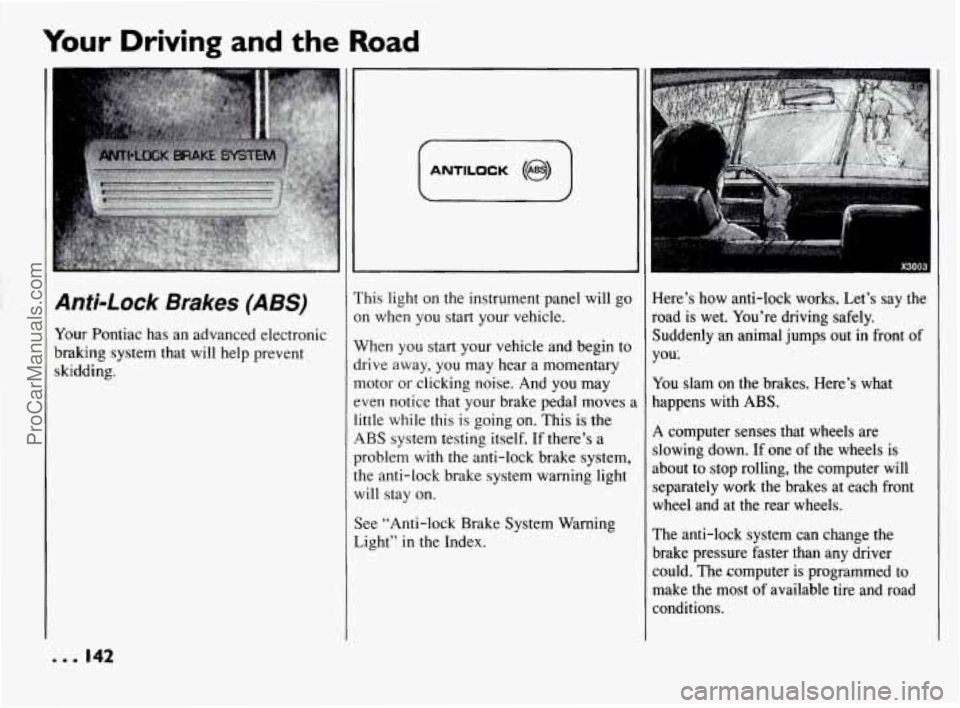
Your Driving and the Road
I
Anti-Lock Brakes (ABS)
Your Pontiac has an advanced electronic
braking system that will help prevent
skidding.
1 ANTILOCK @) 1
This light on the instrument panel will go
on when
you start your vehicle.
When you start your vehicle and begin to
drive away, you may hear a momentary
motor or clicking noise. And you may
even notice that your brake pedal moves
2
little while this is going on. This is the
ABS system testing itself. If there’s a
problem with the anti-lock brake system,
the anti-lock brake system warning light will stay on.
See “Anti-lock Brake System Warning
Light” in the Index. Here’s how anti-lock works. Let’s say the
road
is wet. You’re driving safely.
Suddenly an animal jumps out in front of
you:
You slam on the brakes. Here’s what
happens with
ABS.
A computer senses that wheels are
slowing down.
If one of the wheels is
about to stop rolling, the computer will
separately work the brakes at each front
wheel and at the rear wheels.
The anti-lock system can change the brake pressure faster than any driver
could. The computer is programmed
to
make the most of available tire and road
conditions.
... 142
ProCarManuals.com
Page 144 of 290
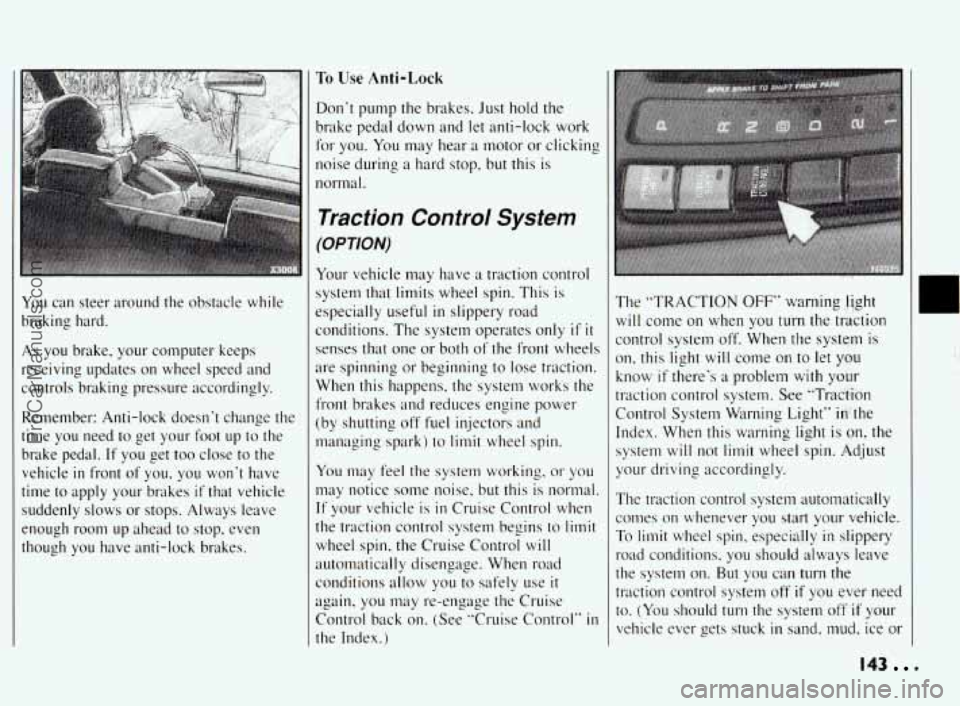
I
You can steer around the obstacle while
braking hard.
As you brake, your computer keeps
receiving updates
on wheel speed and
controls braking pressure accordingly.
Remember: Anti-lock doesn‘t change the
time you need to get your foot up to the
brake pedal.
If you get too close to the
vehicle
in front of you, you won’t have
time to apply your brakes
if that vehicle
suddenly slows
or stops. Always leave
enough room up ahead
to stop, even
though you have anti-lock brakes.
To Use Anti-Lock
Don’t pump the brakes. Just hold the
brake pedal down and let anti-lock work
for you.
You may hear a motor or clicking
noise during a hard stop, but
this is
normal.
Traction Control System
(OPTION)
Your vehicle may have a traction control
system that limits wheel spin. This is
especially useful
in slippery road
conditions. The system operates only
if it
senses that one or both of the front wheels
are spinning or beginning to lose traction.
When this happens, the system works the
front brakes and reduces engine power
(by shutting off fuel injectors and
managing spark) to
limit wheel spin.
You may feel the system working, or you
may notice some noise, but this is normal.
If your vehicle is in Cruise Control when
the traction control system begins
to limit
wheel spin, the Cruise Control will
auto~natically disengage. When road
conditions allow you to safely use
it
again, you may re-engage the Cruise
Control back on. (See “Cruise Control”
in
the Index.) The “TRACTION
OFF” warning
light
will come on when you turn the traction
control system off.
When the system is
on, this light will come
on to let you
know if there’s a problem with your
traction control system. See “Traction
Control System Warning Light” in’the
Index. When this warning light is on, the
system
will not limit wheel spin. Adjust
your driving accordingly.
The traction control system automatically
comes on whenever you start
your vehicle.
To limit wheel spin, especially
in slippery
road conditions, you should always leave
the system
on. But you can turn the
traction control system
off if you ever need
to. (You should
turn the system off if your
vehicle ever gets stuck
in sand. mud, ice or
143
ProCarManuals.com
Page 145 of 290
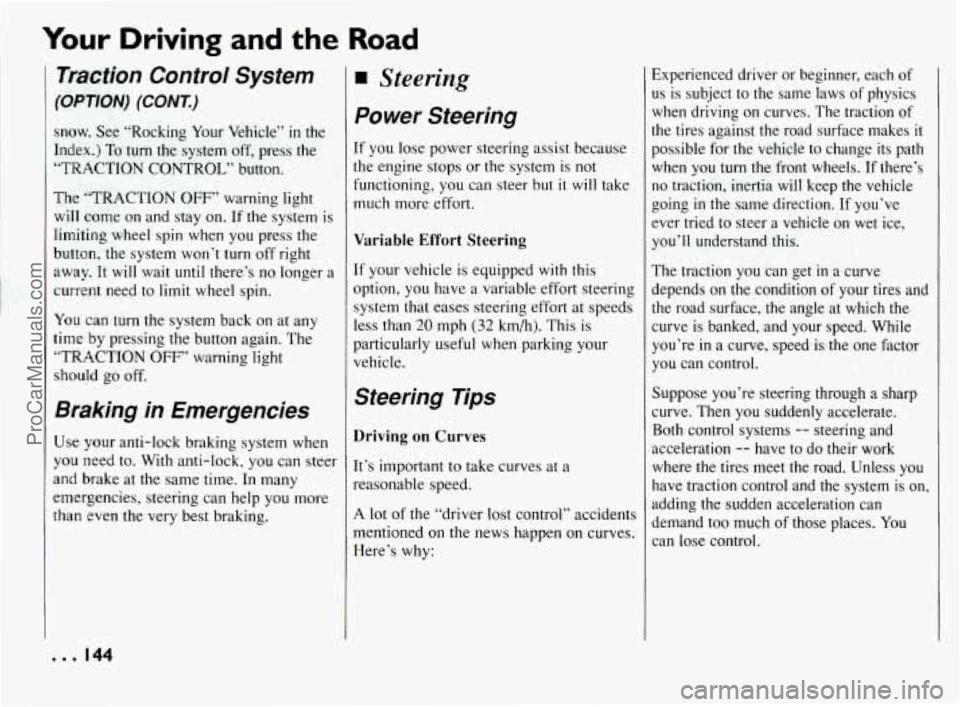
Your Driving and the Road
Traction Control System
(OPTION) (CONI)
snow. See “Rocking Your Vehicle” in the
Index.)
To turn the system off, press the
“TRACTION CONTROL” button.
The “TRACTION
OFF” warning light
will come on and stay on. If the system is
limiting wheel spin when
you press the
button, the system won’t turn off right
away. It will wait until there’s no longer a
current need to limit wheel spin.
You can turn the system back on at any
time by pressing the button again. The
“TRACTION
OFF” warning light
should go off.
Braking in Emergencies
Use your anti-lock braking system when
you need to. With anti-lock, you can steer
and brake at the same time. In many
emergencies, steering can help
you more
than even the very best braking.
Steering
Power Steering
If you lose power steering assist because
the engine stops or the system is not
functioning,
you can steer but it will take
much more effort.
Variable Effort Steering
If your vehicle is equipped with this
option,
you have a variable effort steering
system that eases steering effort at speeds
less than
20 mph (32 km/h). This is
particularly useful when parking your
vehicle.
Steering Tips
Driving on Curves
It’s important to take curves at a
reasonable speed.
A lot of the “driver lost control” accidents
mentioned on the news happen on curves.
Here’s why: Experienced driver or beginner, each
of
us is
subject to the same laws of physics
when driving on curves. The traction
of
the tires against the road surface makes it
possible for the vehicle to change its path when
you turn the front wheels. If there’s
no traction, inertia will keep the vehicle
going in the same direction. If you’ve
ever tried to steer a vehicle on wet
ice,
you’ll understand this.
The traction you can get in a curve
depends on the condition of your tires and
the road surface;
the angle at which the
curve is banked, and your speed. While
you’re in a curve, speed is the one factor
you can control.
Suppose you’re steering through a sharp
curve. Then
you suddenly accelerate.
Both control systems
-- steering and
acceleration
-- have to do their work
where the tires meet the road. Unless
you
have traction control and the system is on,
adding the sudden acceleration can
demand too much
of those places. You
can lose control.
... 144
ProCarManuals.com
Page 148 of 290
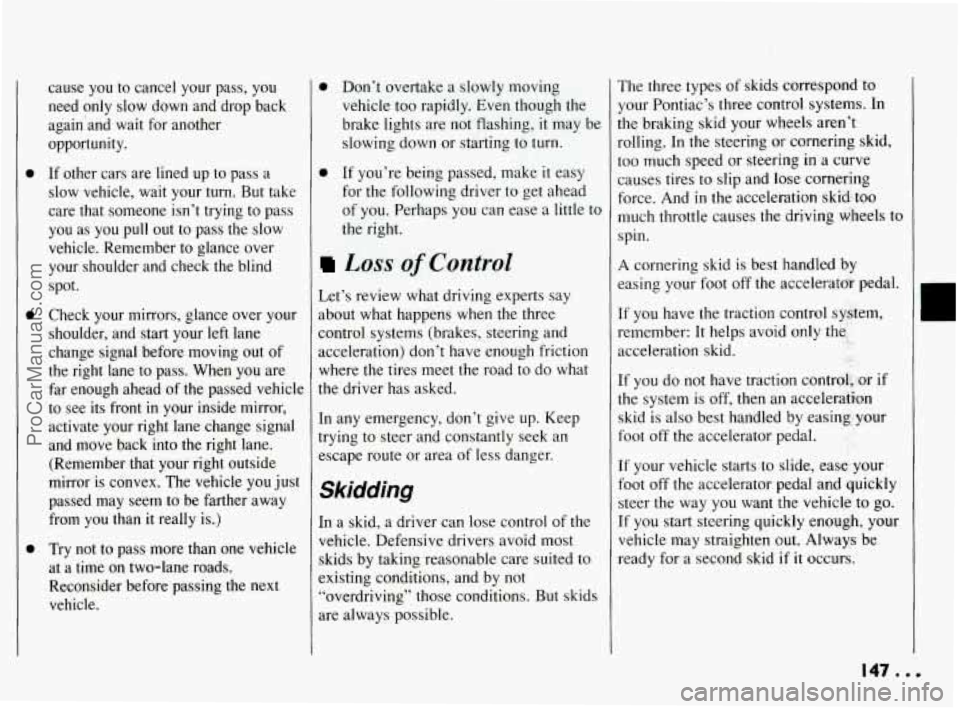
0
0
0
cause you to cancel your pass, you
need only slow down and drop back
again’and wait for another
opportunity.
If other cars are lined up to pass a
slow vehicle, wait your turn. But take
care that someone isn’t trying to pass
you as you pull out to pass the slow
vehicle. Remember to glance over
your shoulder and check the blind
spot.
Check your mirrors, glance over your
shoulder, and start your left lane
change signal before moving out of
the right lane to pass. When you are
far enough ahead of the passed vehicle
to see its front
in your inside mirror,
activate your right lane change signal
and move back into the right lane.
(Remember that your right outside
mirror is convex. The vehicle you just
passed may seem to be farther away
from you than it really is.)
Try not to pass more than one vehicle
at a time on two-lane roads.
Reconsider before passing the next
vehicle.
0 Don’t overtake a slowly moving
vehicle too rapidly. Even though the
brake lights are not flashing, it may be
slowing down or starting to turn.
0 If you’re being passed, make it easy
for the following driver
to get ahead
of you. Perhaps you can ease a little to
the right.
Loss of Control
Let’s review what driving experts say
about what happens when the three
zontrol systems (brakes, steering and
acceleration) don’t have enough friction
where the tires meet the road to do what
the driver has asked.
In any emergency, don’t give up. Keep
trying to steer and constantly seek an
escape route or area of less danger.
Skidding
In a skid, a driver can lose control of the
vehicle. Defensive drivers avoid most
skids by taking reasonable care suited to
existing conditions, and by not
“overdriving” those conditions. But skids
are always possible. The
three types of skids correspond
to
your Pontiac’s three control systems. In
the braking skid your wheels aren’t
rolling. In the steering
or cornering skid,
too much speed or steering in a curve
causes tires to slip and lose cornering
force. And
in the acceleration skic€-.too
much throttle causes the driving wheels to
spin.
A cornering skid is best handled by
easing your foot off the accelerato? pedal.
If you have the traction control system,
remember: It helps avoid only the,
acceleration skid.
If you do not have traction control$ or if
the system is off, then an acceleration
skid is
also best handled by easing your
foot off the accelerator pedal.
If your vehicle starts to slide, ease your
foot off the accelerator pedal and quickly
steer the way you want the vehicle to
go.
If you start steering quickly enough, your
vehicle may straighten out. Always
be
ready for a second skid if it occurs.
147...
ProCarManuals.com
Page 159 of 290
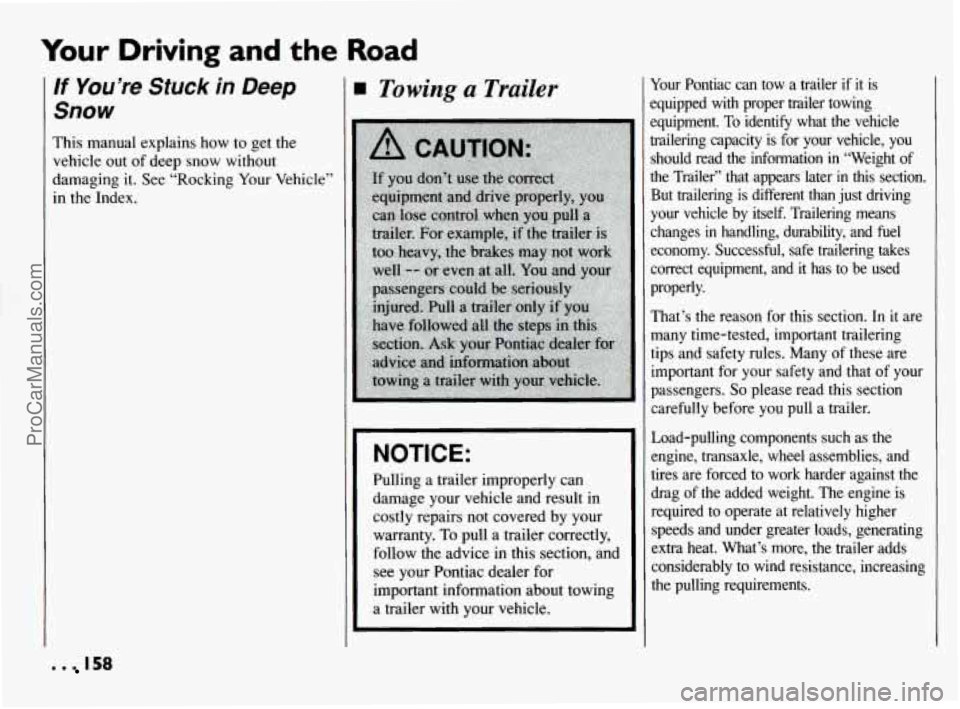
Your Driving and the Road
If You’re Stuck in Deep
Snow
This manual explains how to get the
vehicle out of deep snow without
damaging it. See “Rocking Your Vehicle”
in the Index.
Towing a Trailer
NOTICE:
Pulling a trailer improperly can
damage your vehicle and result in costly repairs not covered by your
warranty.
To pull a trailer correctly,
follow the advice in this section, and
see your Pontiac dealer for
important information about towing
a trailer with your vehicle. Your Pontiac can tow
a trailer
if it is
equipped with proper trailer towing
equipment. To identify what the vehicle
trailering capacity is for your vehicle, you
should read the information
in “Weight of
the Trailer” that appears later
in this section.
But trailering
is different than just driving
your vehicle by itself. Trailering means
changes in handling, durability, and fuel
economy. Successful, safe trailering takes
correct equipment, and it has to
be used
properly.
That’s the reason for this section. In it are
many time-tested, important trailering
tips and safety rules. Many
of these are
important for your safety and that of your
passengers.
So please read this section
carefully before you pull a trailer.
Load-pulling components such as the
engine, transaxle, wheel assemblies, and tires are forced to work harder against the
drag of the added weight. The engine is
required to operate at relatively higher
speeds and under greater loads, generating
extra heat. What’s more, the trailer adds considerably to wind resistance, increasing
the pulling requirements.
. . 158
ProCarManuals.com
Page 163 of 290
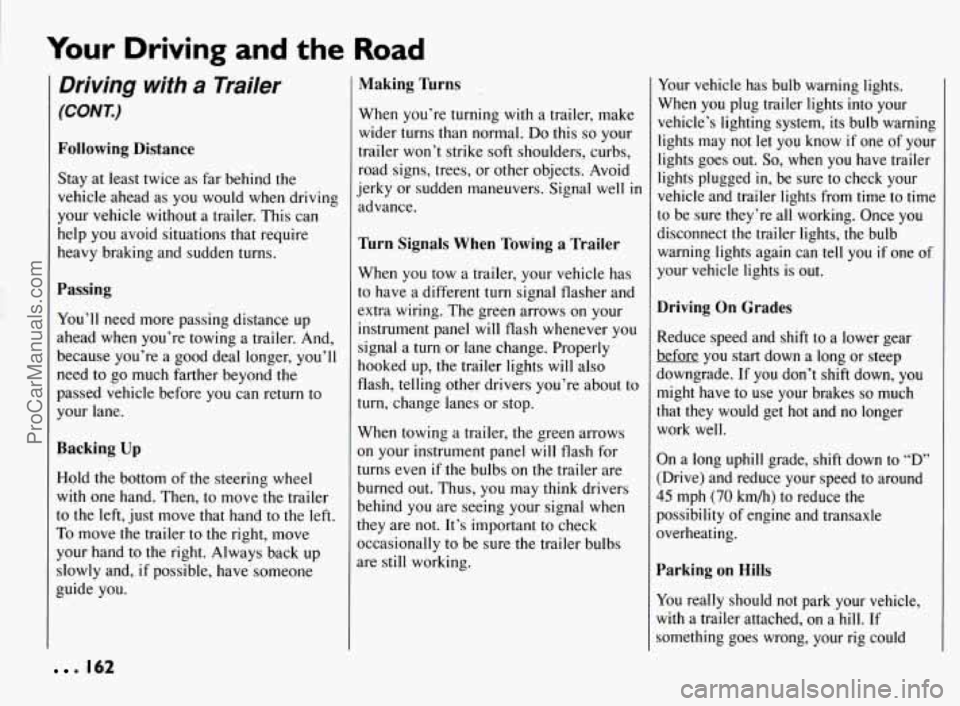
Your Driving and the Road
Driving with a Trailer
(CONT.)
Following Distance
Stay at least twice as far behind the
vehicle ahead as you would when driving
your vehicle without a trailer. This can
help you avoid situations that require
heavy braking and sudden turns.
Passing
You’ll need more passing distance up
ahead when you’re towing a trailer. And,
because you’re a good deal longer, you’ll
need to
go much farther beyond the
passed vehicle before you can return to
your lane.
Backing Up
Hold the bottom of the steering wheel
with one hand. Then, to move the trailer
to the left, just move that hand to the left.
To move the trailer to the right, move
your hand to the right. Always back up
slowly and,
if possible, have someone
guide you.
Making Turns
When you’re turning with a trailer, make
wider turns than normal. Do this
so your
trailer won’t strike soft shoulders, curbs,
road signs, trees, or other objects. Avoid
jerky or sudden maneuvers. Signal well
in
advance.
Turn Signals When Towing a Trailer
When you tow a trailer, your vehicle has
to have a different turn signal flasher and
extra wiring. The green arrows on your
instrument panel will flash whenever you
signal a turn or lane change. Properly
hooked up, the trailer lights will also
flash, telling other drivers you’re about to
turn, change lanes or stop.
When towing a trailer, the green arrows
on your instrument panel will flash for
turns even if the bulbs on the trailer are
burned out. Thus, you may think drivers
behind you are seeing your signal when
they are not. It’s important to check
occasionally to be sure the trailer bulbs
are still working. Your
vehicle has bulb warning lights.
When you plug trailer lights into your
vehicle’s lighting system, its bulb warning
lights may not let
you know if one of your
lights goes out.
So, when you have trailer
lights plugged
in, be sure to check your
vehicle and trailer lights from time
to time
to be sure they’re all working. Once you
disconnect the trailer lights, the bulb
warning lights again can tell you if one
of
your vehicle lights is out.
Driving On Grades
Reduce speed and shift to a lower gear
before you start down a long or steep
downgrade. If you don’t shift down, you
might have to use your brakes
so much
that they would get hot and no longer
work well.
On a long uphill grade, shift down to “D”
(Drive) and reduce your speed to around
45 mph (70 km/h) to reduce the
possibility
of engine and transaxle
overheating.
Parking on Hills
You really should not park your vehicle,
with a trailer attached, on a hill. If
something goes wrong, your rig could
. 162
ProCarManuals.com
Page 171 of 290
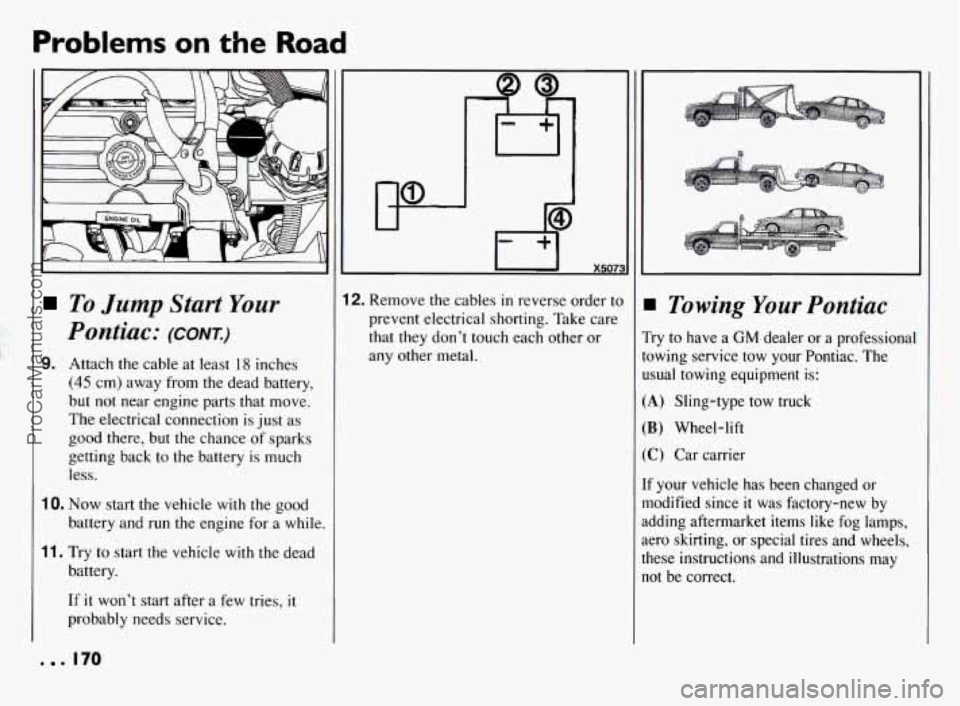
Problems on the Road
To Jump Start Your
Pontiac: (CONT.)
9. Attach the cable at least 18 inches
(45 cm) away from the dead battery,
but not near engine parts that move.
The electrical connection is just as
good there, but the chance of sparks
getting back to the battery is much
less.
16. Now start the vehicle with the good
battery and
run the engine for a while.
11. Try to start the vehicle with the dead
battery.
If it won't start after a few tries, it
probably needs service.
I 0 170
12. Re'move the cables in reverse order to
prevent electrical shorting. Take care
that they don't touch each other or
any other metal. Towing Your Pontiac
Try to have a GM dealer or a professional
towing service tow your Pontiac. The
usual towing equipment is:
(A) Sling-type tow truck
(B) Wheel-lift
(C) Car carrier
If your vehicle has been changed or
modified since it was factory-new by
adding aftermarket items like fog lamps,
aero skirting, or special tires and wheels,
these instructions and illustrations may
not be correct.
ProCarManuals.com
Page 184 of 290
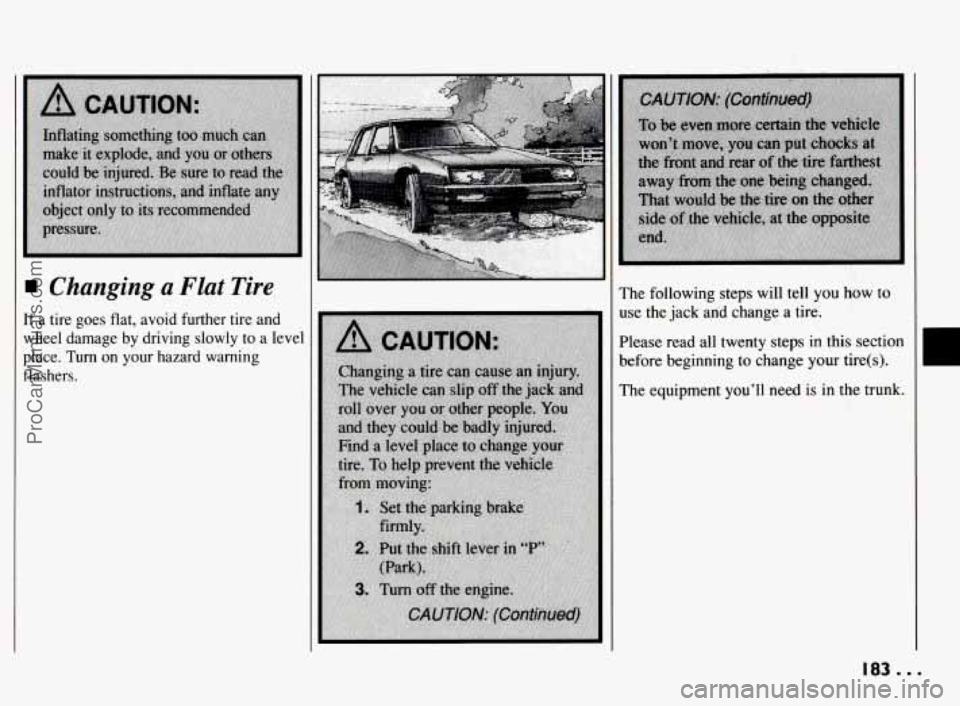
Changing a Flat Tire
If a tire goes flat, avoid further tire and
wheel damage by driving slowly to a level
place.
Turn on your hazard warning
flashers.
..
The following steps will tell you how to
use the jack and change
a tire.
Please read all twenty steps in
this section
before beginning to change your tire(s).
The equipment you’ll need
is in the trunk.
183. ..
ProCarManuals.com
Page 251 of 290
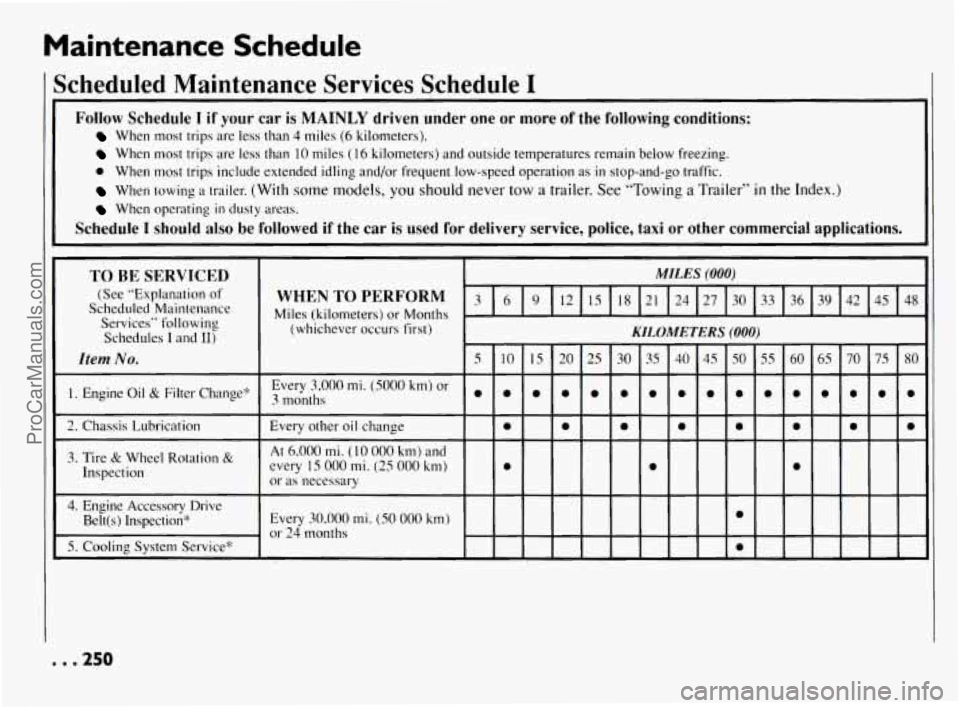
Maintenance Schedule
Scheduled Maintenance Services Schedule I
Follow Schedule I if your car is MAINLY driven under one or more of the following conditions:
When most trips are less than 4 miles (6 kilometers).
When most trips are less than 10 miles (16 kilometers) and outside temperatures remain below freezing.
0 When most trips include extended idling and/or frequent low-speed operation as in stop-and-go traffic.
When towing a trailer. (With some models, you should never tow a trailer. See “Towing a Trailer” in the Index.)
When operating in dusty areas.
Schedule I should also be followed if the car is used for delivery service, police, taxi or other commercial applications.
TO BE SERVICED
(See “Explanation of
Scheduled Maintenance Services” following
Schedules
I and 11)
Item No.
1. Engine Oil & Filter Change”
2. Chassis Lubrication
3. Tire & Wheel Rotation &
Inspection
4. Engine Accessory Drive
Belt(s) Inspection*
5. Cooling System Service* 1
I MILES (000)
(whichever occurs first) I
Every 3,000 mi. (5000 km) or
3 months I I I
Every other oil change I 0
At 6,000 mi. ( 10 000 km) and
every 15
000 mi. (25 000 km) 0
or as necessary
Every
30.000 mi. (50 000 km)
or 24 months
. . .250
ProCarManuals.com